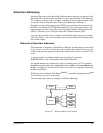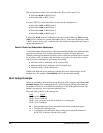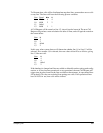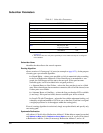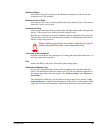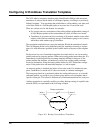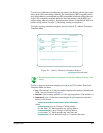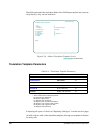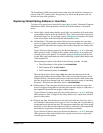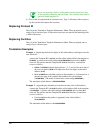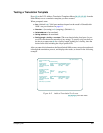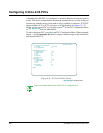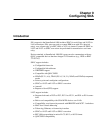
Configuring X.25 8-29
The SmartSwitch 1800 routes traffic based on the user data field if the
U
operator is
present in the SVC routing table. The gateway also allows the
U
operator, and can
include user data field operations.
Replacing Called/Calling Address or User Data
To replace all or part of any of these fields, press
[B]
or
[C]
at the Translation Template
Maintenance Menu. When prompted, enter the desired information as described
below:
L
= Literal digits, which means that the actual digits you enter here will replace that
same number of digits in the specified field. Type
L
followed (with no spaces) by
the desired digits,
0–9
. For example, typing
L1234 [Enter]
will replace four digits
in the selected part of the field with the actual numbers
1234
.
X
= Called address. The characters entered here are not necessarily the exact char-
acters of original called address, but rather the characters (digits or wildcards) of
the template ID that match the original called address (that part not already trans-
lated).
Type
X
followed (with no spaces) by the desired characters,
1–9
,
A–F
, indicating
which positions of the 15 digits in the original called address are to replace the
selected portion of the packet. For example, typing
X1234 [Enter]
takes the first,
second, third, and fourth characters of the (remaining) original called address part
of the template ID.
The matching procedure is described in the following example. Assume:
◆
The called address of the packet is
31101234567800
.
◆
The Template ID is
3110??*U123??
.
◆
The Translation Formula is
L1234X567
.
The translation inserts literal digits
1234
, then takes the characters from the
original called address that match the fifth, sixth, and seventh characters of the
Template ID (
??*
).
??
matches the first two characters from the called address that
have not already been changed (
12
), and
*
matches the entire string of remaining
characters. Therefore, the translation result is
12341234567800
.
G
= Calling address. The characters entered here are not necessarily the exact char-
acters of original calling address, but rather the characters (digits or wildcards) of
the template ID that match the original calling address.
Type
G
followed (with no spaces) by the desired characters,
1–9
,
A–F
, indicating
which positions of the 15 digits in the calling address are to replace the selected
portion of the packet.
U
= Original user data. Note that the user data field is divided into four bytes of pro-
tocol identifier followed by twelve bytes of "real" user data; the only part that can
be changed here is the real user data. The characters entered here are not the actual
characters of user data, but the characters (digits or wildcards) of the template ID
that match the original user data (that part not already translated).
Type
U
followed (with no spaces) by the desired characters,
1–9
,
A–C
, indicating
which positions of the twelve digits in the original user data are to replace the
selected portion of the packet.



